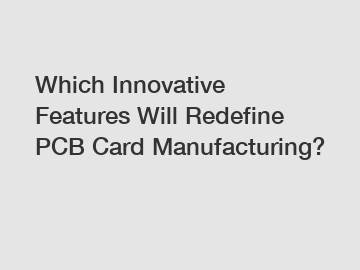Which Innovative Features Will Redefine PCB Card Manufacturing?
Which Innovative Features Will Redefine PCB Card Manufacturing?
In recent years, the PCB (Printed Circuit Board) industry has witnessed remarkable advancements, thanks to continuous innovation and technological progress. PCB card manufacturing has undergone significant transformations, driven by the need for more efficient and compact electronic devices. These advancements have revolutionized the way PCBs are designed, fabricated, and tested. In this article, we will explore the innovative features that are redefining PCB card manufacturing.
1. Miniaturization and Increased Density.

Miniaturization and increased density are among the most noticeable features impacting PCB card manufacturing. As technology evolves, the demand for smaller and more powerful electronic devices is on the rise. Manufacturers are constantly challenged to reduce the size of PCBs while accommodating a growing number of components. Advanced manufacturing processes and clever design techniques have enabled the production of highly compact PCBs without compromising on functionality or reliability.
2. Flexible and Rigid-Flex PCBs.
Flexible and rigid-flex PCBs have gained significant attention in recent years, providing new possibilities for designing electronic devices. These PCBs allow for more complex layouts and offer greater flexibility in terms of form factor. Flexible PCBs can be bent or twisted, making them suitable for applications requiring flexibility, such as wearable devices and curved displays. Rigid-flex PCBs combine both rigid and flexible areas, providing the best of both worlds. These innovative PCB types open doors to new design choices and enhance product durability.
3. Integration of IoT Connectivity.
The Internet of Things (IoT) has become an integral part of our daily lives, and PCB manufacturers are adapting to this trend by integrating IoT connectivity features into their products. IoT-enabled PCBs contain built-in wireless modules that enable connectivity with other devices and the cloud. This feature facilitates a wide range of applications, such as home automation, industrial monitoring, and smart healthcare devices. The integration of IoT connectivity in PCBs is revolutionizing industries and paving the way for a more connected future.
4. Surface Mount Technology.
Surface Mount Technology (SMT) has been a game-changer in PCB card manufacturing. SMT components are smaller and lighter, allowing for higher component density on PCBs. This technology has replaced through-hole mounting, reducing manufacturing costs and allowing for automated assembly processes. SMT also improves electrical performance, as the shorter connections between components result in reduced parasitic capacitance and inductance. The widespread adoption of SMT has led to more efficient PCB designs and manufacturing processes.
Closing paragraph:
In conclusion, the PCB card manufacturing industry is witnessing a transformative phase, driven by various innovative features. Miniaturization and increased density, flexible and rigid-flex PCBs, integration of IoT connectivity, and surface mount technology are among the key factors redefining PCB manufacturing. These advancements have allowed for the development of smaller, more powerful, and versatile electronic devices. If you are looking to embrace these innovative features and stay ahead in the rapidly evolving world of PCB manufacturing, contact us for more information on our services and how we can assist you.
(Note: Kindly note that the "contact us" mentioned above is a placeholder and should be replaced with the appropriate contact details of the relevant company or entity.).
For more information, please visit PCB Inspection technology, PCB AOI Machine, Intelligent X-Ray Parts Counter.

Comments
0